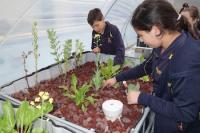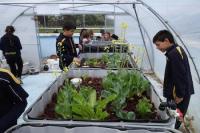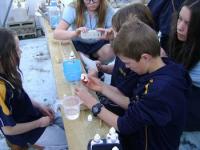Aquaponics
Growing plants with aquaponics
'We have a fish tank with goldfish and the fish pee and poo after we feed them. There is a pipe that connects to the fish tank and grow beds. The waste goes through the pipe to the grow beads. The waste grows the plants. Every 15 minutes the water drains through a pipe called an auto siphon which drains the water from the grow beds to the sump tank. A small pump returns the water back up and it goes back to the grow beds and fish tank. The plants are cleaning the water.
This unit is good because we are growing organic - chemical free food and saving water. We give the organic grown vegetables and fruit to the community and we use them in the school too.
The unit is a closed system we are not having to fill it up with water all the time so we are saving water. We top it up with rain water if any evaporates.'
The aquaponics growing unit
Aquaponics is simply growing produce with fish waste in a closed water system. The process is chemical free and reuses the water.
We feed our goldfish and they provide the waste which is circulated around the grow beds and the plants use the nutrients produced to grow into lovely healthy food for our children and community. The system uses auto siphons to regulate the water in the beds with a small pump maintaining continued circulation around beds and fish tank. The plants keep the water clean.
The unit is built in our decommissioned swimming pool complex. By utilising this area it has saved tons of waste entering our local landfill. The pool area is covered with a FlexiTunnel and needs little maintenance. The changing sheds have been transformed into tool and work rooms. The security fence provides a safe environment for our unit.
We are experimenting with growing mediums by using clay beads in one set-up with volcanic scoria in the other. The different mediums allow for stability for high growing plants like tomatoes and spinach or spreading bulb type varieties like beetroot and carrots.
The fish tanks are 1,000 litres each with three grow beds operating per tank. They work on a 1:1 ratio. The number of fish per unit depends on several aspects including the plants we are growing, temperatures, bacteria etc.The students are hands-on with all aspects of running the aquaponics unit. They have learnt how and why to test the water and now carry out the testing of the units. Testing is done to check the levels of pH, ammonia, nitrites and nitrates. The temperature is tracked for outside and inside the growing tunnel as well as each fish tank. Planting and growth time details are compared and the information is recorded. The fish are fed every couple of days. Good water quality and the supply of natural nutrients are achieved by a well balanced unit.
'I think the aquaponics is really good because it is chemical free, we are recycling water and the fish provide all the plant food.'
'We are now doing the weekly water testing and record the readings in a book. Our adults watch us. The results tell us what is happening in our grow beds.'
'Some of us have been doing talks with visiting groups and doing presentations at community group meetings. We explain how the unit works.'
'We like the aquaponics unit because it's chemical free and we are recycling water.'




